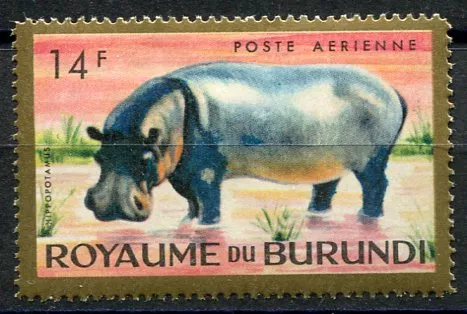- Home
- Philately: postage stamps
- Philately: stamps all over the world
- Africa
- Burundi
- (1964) MiNr. 105 A ** - Burundi - Aerial Stamp - Amphibious Hippopotamus
(1964) MiNr. 105 A ** - Burundi - Aerial Stamp - Hippopotamus amphibius
Burundi - postage stamps.

| Code: | BUR-105A |
| Producer: | Burundi |
| Price: | 1,17 EUR |
| Availability: | In Stock |
| Stock: | 1 Pcs |
| Denomination of the stamp: | 14 F |
| Year: | 1964 |
| Condition: | ** |
| Catalogue no. (MICHEL): | 105 A |
| Cat. number (St. Gibbons): | 95 |
| Cat. number (Yvert et Tellier): | PA 4 |
The Amphibian Hippopotamus amphibius: How one of the largest land mammals lives
The amphibian hippopotamus (Hippopotamus amphibius) is one of the largest mammals on the African continent. Although it is partly adapted to life in water, it is neither marine nor entirely aquatic - the hippopotamus is typically an amphibious species. In this article, we look at its biology, ecology and specific adaptations to life in both aquatic and terrestrial environments.
Taxonomy and appearance
The amphibian hippopotamus belongs to the order Artiodactyla, and its closest living relatives are not, as one might think, pigs, but cetaceans (such as whales and dolphins). The body of the hippopotamus is massive, cylindrical, with short limbs and thick, hairless skin. Adults can weigh between 1,500 and 3,200 kilograms.
Habitat and distribution
The natural habitat of the amphibian hippopotamus is the slow-moving rivers, lakes and swamps of sub-Saharan Africa. It requires constant access to water because water helps regulate its body temperature and protects its skin from drying out and overheating. Hippos live in groups, often numbering several dozen individuals.
Food and feeding
The hippopotamus is an herbivore. It takes most of its food at night, when it leaves the water and ventures onto land. There it grazes mainly on grass, and can travel up to several kilometres in a single night, consuming 30 to 50 kg of vegetation. Despite its size and huge jaws, the hippo feeds exclusively on plant food.
Reproduction and Life Cycle
The female hippopotamus gives birth to one young after a gestation period lasting approximately eight months. Parturition usually takes place in water. The young learn to swim immediately after birth and are nursed until about six to eight months. Hippos reach sexual maturity around the age of 7 to 9 years.
Social structure and behaviour
Peafs are known for their territorial behavior, especially in the water. Males guard a section of river or lake where their harem of females live. On land, however, they are less territorial. Hippos communicate through vocal displays, scent markings and postural behaviour.
Conservation and threats
Although the amphibian hippopotamus is not on the brink of extinction, it is classified as a vulnerable species by the IUCN. The main threats are loss of habitat, conflicts with humans and illegal hunting - mainly for its ivory fangs and meat.
Frequently Bought Together - (1964) MiNr. 105 A ** - Burundi - Aerial Stamp - Hippopotamus amphibius
From the Same Category - (1964) MiNr. 105 A ** - Burundi - Aerial Stamp - Hippopotamus amphibius
Burundi - postage stamps. Burchell's zebra (Equus burchelli): the unique striped pattern of the African savannah The Burchell's zebra (Latin Equus burchelli, sometimes also referred to as Equus quagga burchellii) is one of the best-known subspecies ...
Burundi - postage stamps. * - slight fingerprint on glue on approx. 3 marks
Burundi - postage stamps. Guereza guereza (Colobus guereza): the elegant acrobat of the African rainforest The mantled guereza is a magnificent primate native to Africa's tropical forests and savannahs. Its distinctive black and white coat and long ...





